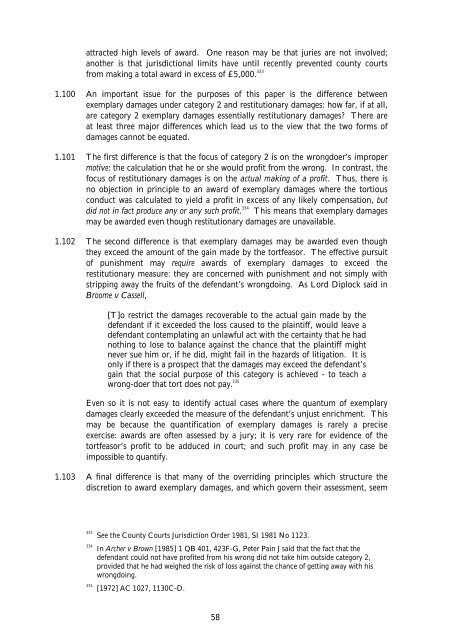Aggravated, Exemplary and Restitutionary ... - Law Commission
Aggravated, Exemplary and Restitutionary ... - Law Commission
Aggravated, Exemplary and Restitutionary ... - Law Commission
Create successful ePaper yourself
Turn your PDF publications into a flip-book with our unique Google optimized e-Paper software.
attracted high levels of award. One reason may be that juries are not involved;<br />
another is that jurisdictional limits have until recently prevented county courts<br />
from making a total award in excess of £5,000. 333<br />
1.100 An important issue for the purposes of this paper is the difference between<br />
exemplary damages under category 2 <strong>and</strong> restitutionary damages: how far, if at all,<br />
are category 2 exemplary damages essentially restitutionary damages? There are<br />
at least three major differences which lead us to the view that the two forms of<br />
damages cannot be equated.<br />
1.101 The first difference is that the focus of category 2 is on the wrongdoer’s improper<br />
motive: the calculation that he or she would profit from the wrong. In contrast, the<br />
focus of restitutionary damages is on the actual making of a profit. Thus, there is<br />
no objection in principle to an award of exemplary damages where the tortious<br />
conduct was calculated to yield a profit in excess of any likely compensation, but<br />
did not in fact produce any or any such profit. 334<br />
This means that exemplary damages<br />
may be awarded even though restitutionary damages are unavailable.<br />
1.102 The second difference is that exemplary damages may be awarded even though<br />
they exceed the amount of the gain made by the tortfeasor. The effective pursuit<br />
of punishment may require awards of exemplary damages to exceed the<br />
restitutionary measure: they are concerned with punishment <strong>and</strong> not simply with<br />
stripping away the fruits of the defendant’s wrongdoing. As Lord Diplock said in<br />
Broome v Cassell,<br />
[T]o restrict the damages recoverable to the actual gain made by the<br />
defendant if it exceeded the loss caused to the plaintiff, would leave a<br />
defendant contemplating an unlawful act with the certainty that he had<br />
nothing to lose to balance against the chance that the plaintiff might<br />
never sue him or, if he did, might fail in the hazards of litigation. It is<br />
only if there is a prospect that the damages may exceed the defendant’s<br />
gain that the social purpose of this category is achieved - to teach a<br />
wrong-doer that tort does not pay. 335<br />
Even so it is not easy to identify actual cases where the quantum of exemplary<br />
damages clearly exceeded the measure of the defendant’s unjust enrichment. This<br />
may be because the quantification of exemplary damages is rarely a precise<br />
exercise: awards are often assessed by a jury; it is very rare for evidence of the<br />
tortfeasor’s profit to be adduced in court; <strong>and</strong> such profit may in any case be<br />
impossible to quantify.<br />
1.103 A final difference is that many of the overriding principles which structure the<br />
discretion to award exemplary damages, <strong>and</strong> which govern their assessment, seem<br />
333 See the County Courts Jurisdiction Order 1981, SI 1981 No 1123.<br />
334 In Archer v Brown [1985] 1 QB 401, 423F-G, Peter Pain J said that the fact that the<br />
defendant could not have profited from his wrong did not take him outside category 2,<br />
provided that he had weighed the risk of loss against the chance of getting away with his<br />
wrongdoing.<br />
335 [1972] AC 1027, 1130C-D.<br />
58
















